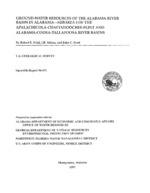Drought conditions in the 1980's focused attention on the multiple uses of the surface- and ground-water resources in the Apalachicola-Chattahoochee-Flint (ACF) and Alabama-Coosa-Tallapoosa (ACT) River basins in Georgia, Alabama, and Florida. State and Federal agencies also have proposed projects that would require additional water resources and revise operating practices within the river basins. The existing and proposed water projects create conflicting demands for water by the States and emphasize the problem of water-resource allocation. This study was initiated to describe ground-water availability in the Alabama River basin of Alabama, Subarea 8 of the ACF and ACT River basins, and to estimate the possible effects of increased ground-water use within the basin. Subarea 8 encompasses about 6,750 square miles in the Coastal Plain physiographic province in central and southwestern Alabama. The Alabama River extends from the juncture of the Coosa and Tallapoosa Rivers near the city of Montgomery, to its juncture with the Tombigbee River, near the town of Calvert in Washington County. Subarea 8 includes the Cahaba River basin from the physiographic 'Fall Line' at the city of Centreville in Bibb County, to its mouth in Dallas County; and the Alabama River basin from near Montgomery to the Alabama River cutoff, about 6 miles northeast of its juncture with the Tombigbee River. The study area is underlain by sedimentary deposits of Cretaceous, Tertiary, and Quaternary ages. Major aquifers underlying Subarea 8 are, from shallowest to deepest, the Coastal lowlands aquifer system, the Floridan aquifer system, the Lisbon aquifer, The Nanafalia-Clayton aquifer, the Ripley aquifer, the Eutaw aquifer, and the Tuscaloosa aquifer. The conceptual model described for this study qualitatively subdivides the ground-water flow system into local (shallow), intermediate, and regional (deep) flow regimes. Ground-water discharge to tributaries mainly is from local and intermediate flow regimes and varies seasonally. The regional flow regime probably approximates steady- state conditions and discharges chiefly to major drains such as the Alabama River, and in upstream areas, to the Cahaba River. Ground-water discharge to major drains originates from all flow regimes. Mean-annual ground-water discharge to streams (baseflow) is considered to approximate the long-term, average recharge to ground water. The mean-annual baseflow was estimated using an automated hydrograph- separation method, and represents discharge from the local, intermediate, and regional flow regimes of the ground-water flow system. Mean-annual baseflow discharging from Subarea 8 was estimated to be 20,300 cubic feet per second. Mean-annual baseflow represented about 61 percent of total mean-annual stream discharge for the period of record. Estimated and measured stream discharge for selected sites on the Alabama River and its tributaries were compiled for the years 1941, 1954, and 1986, during which sustained droughts occurred throughout most of the ACF-ACT area. Stream discharges were assumed to be sustained entirely by baseflow during the latter periods of these droughts. Estimated baseflow near the end of the individual drought years was about 17 percent of the estimated mean-annual baseflow at the Alabama River cutoff, the most downstream point of Subarea 8. The potential exists for the development of ground-water resources on a regional scale throughout Subarea 8. Estimated ground-water use in 1990 was less than 1 percent of the estimated mean-annual baseflow, and about 2.4 percent of baseflow during the droughts of 1941, 1954, and 1986. Because ground-water use in Subareas 5 and 6 represents a relatively minor percentage of ground-water recharge, even a large increase in ground-water use in Subareas 5 and 6 in Georgia probably would have little effect on the quantity of ground water and surface water in Alabama. In addition, ground-water use in Subarea 3 in Georgia probably h


